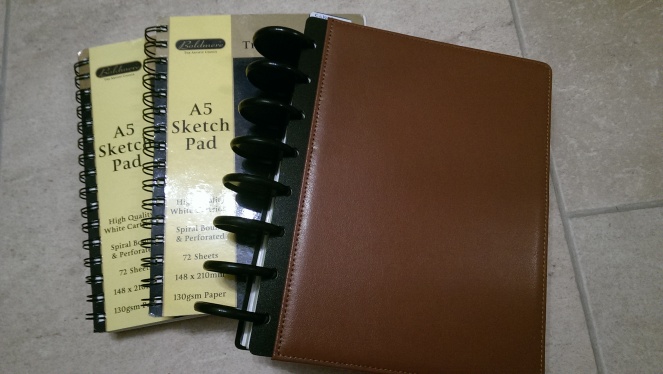I’ve always been someone who likes to write things down – Christmas present lists, interesting quotes, ideas for short stories, if I don’t jot them somewhere, they’re likely to be forgotten.
Up until lately, I had been using cheap sketchbooks from a stationery shop in order to do this, which I liked because the paper was nice and thick, they’d withstand being chucked into my bag and the fact that they weren’t particularly beautiful meant filling them with my scrawl didn’t make me feel too bad (I’ve had stunning notebooks in the past and they remained blank because no idea seemed important enough to sully their perfect pages with).
However, after filling several of these books, the system started to break down a little. I often started stories or even parts of novels in them, then broke off for whatever reason – and those snippets got lost and forgotten about. I found an old notebook in October last year (2016) and discovered loads of fragments that might have turned into really good stories or craft projects, had I ever finished them or even looked at them again. My carefully jotted down notes, card layouts and other useful stuff were getting buried among reminders to myself about appointments, directions to places we were visiting and other transient things. It was also really annoying that I had left pages blank, obviously intending to go back to various things at some point but unsure as to how much space I’d need.
I started to wonder if there wasn’t a better system that would allow me to keep this kind of rolling notebook but make it more manageable and less cumbersome than the A4 ringbinder I had tried. So, I went online – and there it was! The discbound notebook.
I must point out that this isn’t a new thing at all: discbound notebooks have been around for years, but I’d just never heard of them. A number of different brands make them, from Me and My Big Ideas (The Happy Planner) and Martha Stewart to office supply store Staples (unfortunately soon to be defunct). They are basically plastic or leather covers held together by plastic or metal discs instead of spiral binding or in a ring-binder style. You can buy special paper for them or get hold of a punch to make your own. Once you’ve put your inserts in, you can move the pages around at will, meaning you can make a really thick notebook, take projects out once they’re finished or add pages to something ongoing.
I chose the Staples Arc leather cover in brown after finding a good deal on eBay and after using it for several months now, I’m really pleased with it. I upgraded the standard rings to some bigger ones (although I might actually have gone too big and am considering swapping again for the medium-sized) and I can fit all kinds of things in there, all neatly split up into sections using the brand’s plastic dividers.
I’ve got story submission records so I can keep tabs on competition entries and feel motivated to send more out; there’s a simplified calendar that allows me to jot down what I did each day (and so it’s obvious if I’ve been really lazy); there are to-do lists and notes to self; and finally, there’s a section where I can start pieces of prose but also see them through to completion.
Now, if I come up with a story idea, I jot down the basic outline or bits of inspiration that have led me to it, then begin writing like I usually do, longhand. However, when I need to break off, I keep the fragment in the story section. There’s no need to leave pages blank, because I can move paper to that part later. It doesn’t get forgotten because it’s right there in that specially divided section. When I’ve gone back to it and either finished the story or decided it’s not really going anywhere, I can take the pages out, archive them and work on something else. I’m even thinking of starting a contents page at the beginning of this section so I can see at a glance what there is in there and what needs finishing off.
I’ve definitely found that the discbound system is working better than my old method. I managed to enter four short story competitions in January 2017 and I also sent off a couple of magazine fillers, which is a lot more than usual. I also feel as though I’m keeping hold of ideas and projects more effectively, rather than simply starting lots of things and feeling frustrated because nothing ever really gets done.
If you’re a stationery enthusiast reading this and have known about/been using discbound for years, it’s a bit like preaching to the converted. However, since I had never heard of this whole new world of ‘plannering’ and the Arc was a total revolution, I thought I’d share this post. Perhaps it will help someone out there get organised!
Of course, since ‘discovering’ the Arc, I’ve also found Simple Stories, Dokibook, Webster’s Pages – and rediscovered Filofax. I’ve fallen down a rabbit hole of planners (ringbound as well as discbound) and and am now completely obsessed, so you can no doubt look forward to plenty more posts on this topic in the not-too-distant future.
In the meantime, I’d love to know what you use, how you got started on your planner road and what system has helped you achieve your organisational goals?

